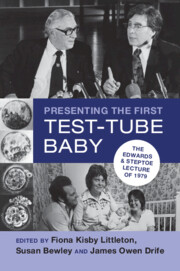Book contents
- Presenting the First Test-Tube Baby
- Presenting the First Test-Tube Baby
- Copyright page
- Contents
- Illustrations
- Tables
- Acknowledgements
- Foreword
- Abbreviations
- 1 Introduction
- 2 From Oldham and Cambridge to the Rest of the World
- 3 The Lecture, 1979
- 4 The Professional Reminiscence, 2019
- 5 The Local Reminiscence
- 6 The Legacy
- Index
- References
4 - The Professional Reminiscence, 2019
Retired Fellows Look Back
Published online by Cambridge University Press: 23 February 2023
- Presenting the First Test-Tube Baby
- Presenting the First Test-Tube Baby
- Copyright page
- Contents
- Illustrations
- Tables
- Acknowledgements
- Foreword
- Abbreviations
- 1 Introduction
- 2 From Oldham and Cambridge to the Rest of the World
- 3 The Lecture, 1979
- 4 The Professional Reminiscence, 2019
- 5 The Local Reminiscence
- 6 The Legacy
- Index
- References
Summary
This chapter describes, and transcribes in full, a Reminiscence event in which ten original members of the audience of the 1979 lecture were invited to talk about their impressions of the meeting forty years before. They describe the atmosphere and reflect on how things were considered then and now. Notes explaining other relevant work and biographies of individuals mentioned are appended.
Keywords
- Type
- Chapter
- Information
- Presenting the First Test-Tube BabyThe Edwards and Steptoe Lecture of 1979, pp. 131 - 178Publisher: Cambridge University PressPrint publication year: 2023



